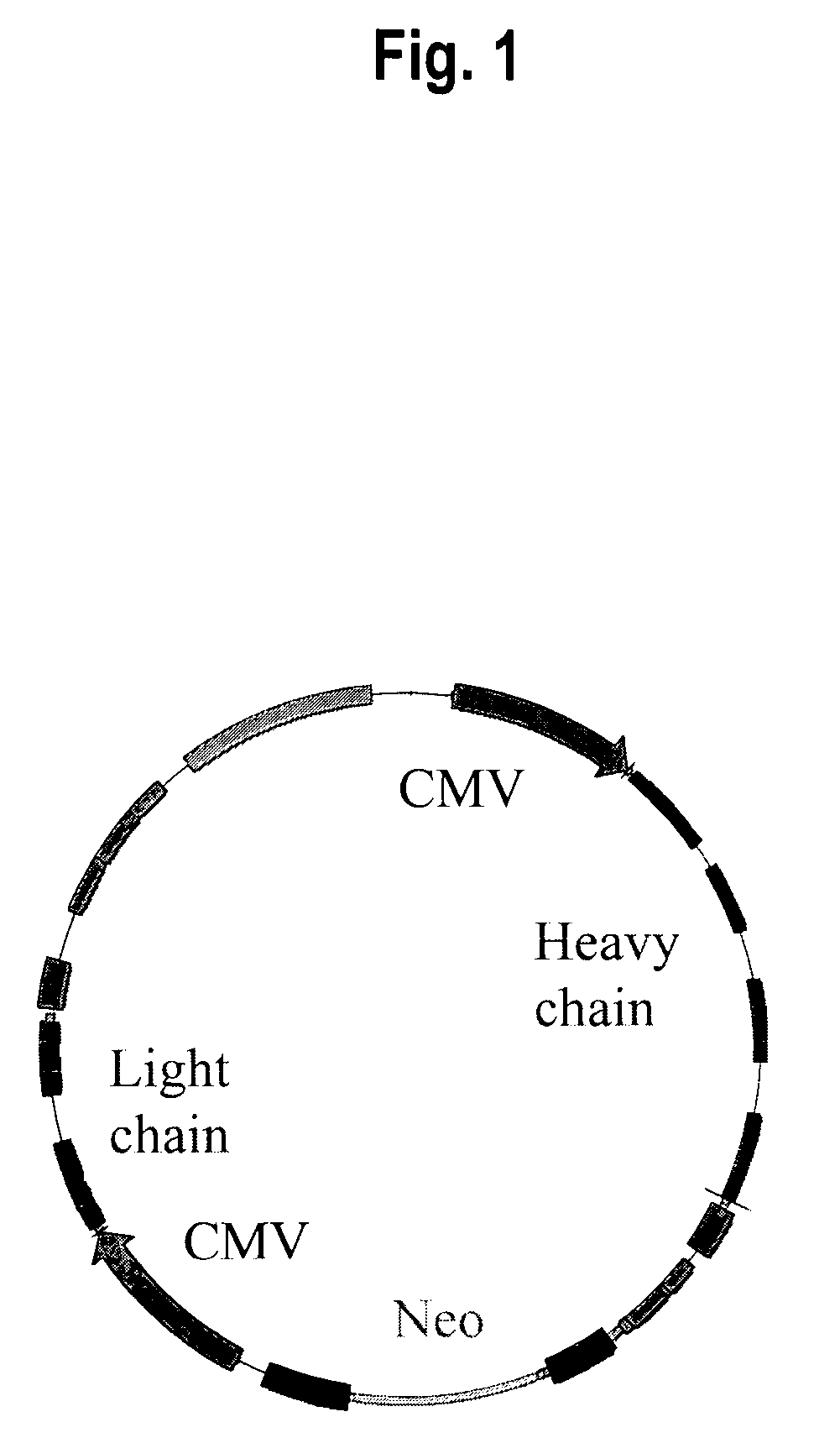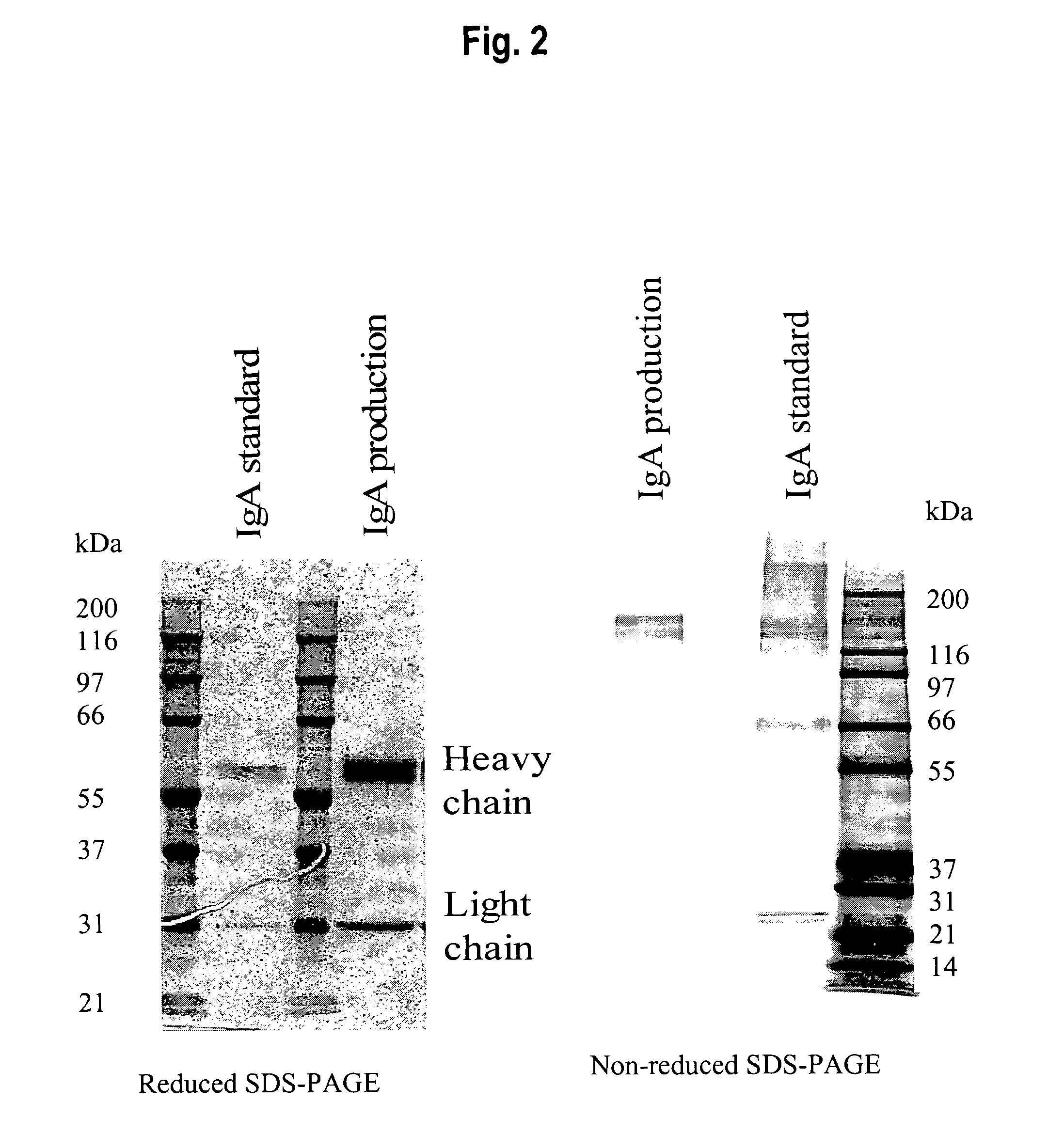Efficient production of IgA in recombinant mammalian cells
a technology of iga and mammalian cells, applied in the field of recombinant protein production, can solve the problems of high transgene copy number, cell instability, and inability to effectively activate neutrophils, and achieve the effect of high iga productivity, efficient production and secretion
- Summary
- Abstract
- Description
- Claims
- Application Information
AI Technical Summary
Benefits of technology
Problems solved by technology
Method used
Image
Examples
examples
[0031]The invention will now be described by some illustrative examples. In practice, the invention generally employs, unless otherwise indicated, conventional techniques of immunology, molecular biology, microbiology, microbiology, cell biology, and recombinant DNA, which are within the skill of the art. See, e.g., Sambrook, J. and Russell, D. W. (2001), Molecular cloning: a laboratory manual, Pub. Cold Spring Harbor Laboratory Press; Current Protocols in Molecular Biology, Ausubel F. M., et al., eds, 1987; the series Methods in Enzymology (Academic Press, Inc.); PCR2: A Practical Approach, MacPherson M. J., Hams B. D., Taylor G. R., eds, 1995; Antibodies: A Laboratory Manual, Harlow and Lane, eds, 1988.
example i
Construction of pEpcamIgA Expression Vector
[0032]An expression plasmid was generated which encodes both the light and heavy chains of an IgA antibody that recognizes EpCAM. The DNA encoding the antigen-binding region of this antibody was first isolated from a scFv phage display library (Huls et al., 1999). A leader sequence and constant regions were added essentially as described in Boel et al., 2000. The genomic DNA encoding the light and heavy chains (genomic sequences of the antibody-encoding regions provided in SEQ ID NO:1 and SEQ ID NO:2, amino acid sequences of the encoded anti-EpCAM IgA provided in SEQ ID NO:3 and SEQ ID NO:4) were then amplified using PCR to append convenient restriction sites, and then cloned into the expression vector pcDNA3002(Neo). The following primers were used for PCR of the light chain:
[0033]
(SEQ ID NO: 5)E001: CCTGGCGCGCCACCGCATGCCCTGGCTTCCTGTGG(SEQ ID NO: 6)E002: CCGGGTTAACTAACACTCTCCCCTGTTGAAGC.
[0034]The following primers were used for PCR of the ...
example ii
Transfection of PER.C6™ Cell Line and Production of IgA
[0037]Cells were transfected with pEpcamIgA by a Lipofectamine based method. In brief, PER.C6™ cells were seeded at 3.5×106 cells per 96 mm tissue culture dish. For each dish, 2 μg plasmid DNA was mixed with 10 μl Lipofectamine (Gibco); this was added to the cells in serum free DMEM medium (total volume 7 ml) and incubated for four hours. This was then replaced with DMEM medium (i.e., containing serum). The following day (and for the ensuing three weeks) cells were grown in DMEM medium in the presence of 0.5 mg / ml Geneticin (G418) to select for clones that were stably transfected with the plasmid. Clones were tested for IgA productivity by ELISA analysis. In brief, cells were plated at 0.5×106 cells per well of a 6-well dish in DMEM serum. These were incubated for four days, after which time supernatant was harvested and IgA concentration measured. For ELISA analysis, wells of a 96-well plate were coated with antibody raised aga...
PUM
| Property | Measurement | Unit |
|---|---|---|
| total volume | aaaaa | aaaaa |
| molecular weight | aaaaa | aaaaa |
| molecular weight | aaaaa | aaaaa |
Abstract
Description
Claims
Application Information
 Login to View More
Login to View More - R&D
- Intellectual Property
- Life Sciences
- Materials
- Tech Scout
- Unparalleled Data Quality
- Higher Quality Content
- 60% Fewer Hallucinations
Browse by: Latest US Patents, China's latest patents, Technical Efficacy Thesaurus, Application Domain, Technology Topic, Popular Technical Reports.
© 2025 PatSnap. All rights reserved.Legal|Privacy policy|Modern Slavery Act Transparency Statement|Sitemap|About US| Contact US: help@patsnap.com



